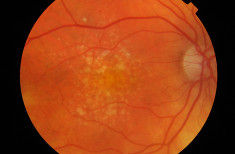Mr Haris Papanikolaou
Consultant Ophthalmologist
Age-related macular degeneration (AMD) is a condition that affects a part of the retina at the back of the eye called the macula. AMD causes problems with central vision. It does not cause total blindness and is not painful.
The exact cause for AMD is not known but some things are thought to increase chances of developing AMD.
These include age, gender, genes, smoking, sunlight exposure and diet.
Usually one of the first things that people notice is loss of ability to see detail and read small print. Some people experience a blurred area in the centre of their vision and others complain that straight lines look distorted and wavy.
There are two main types of AMD - "wet" AMD and "dry" AMD. This does not have anything to do with how the eye feels or if you suffer from dry or watery eyes.
Dry AMD
Dry AMD is the more common type. It usually develops very slowly and causes gradual deterioration of central vision. Dry AMD usually takes a long time to reach end stage.
Wet AMD
Wet AMD affects about 10-15% of people who develop AMD. Abnormal blood vessels grow underneath the macula leading to fluid build up and bleeding. If not treated, eventually scarring develops which damages the central vision.
Wet AMD can be very aggressive and may lead to significant loss of vision in a very short period of time.
Treatment
At the moment unfortunately there is no treatment for dry AMD.There is some evidence that high doses of vitamin A, C, E and the minerals zinc and copper when taken together may help slow down the progression of dry AMD
Treatment however is available for wet AMD. This stops the new vessels from growing and causing damage. The sooner the treatment is started the better the outcome, before the new blood vessels do too much damage. If the blood vessels are left untreated, the scarring and the sight loss it causes is usually permanent.
Treatment for wet AMD
Anti Vascular Endothelial Growth Factor (Anti-VEGF) treatment
Anti-VEGF drugs stop the abnormal vessels from growing. By stopping blood vessels growing and leaking, further damage to the sight is prevented.
The medicine has to be injected into the vitreous, the gel-like substance inside the eye. This is called an intravitreal injection.
Usually a course of injections is needed.
Anti-VEGF treatments have a high success rate and in most people they stop sight getting worse. About 25-30 per cent of people could also see an improvement in their vision.


Example of Atrophic AMD
Example of Dry AMD
Example of Wet AMD
